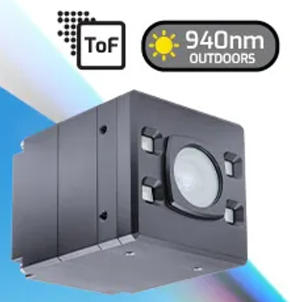
The Lucid Vision Labs Helios®2 Ray Time of Flight (ToF) 3D monochrome camera is designed for outdoor1 3D imaging. The Helios2 Ray 3D ToF camera features a Sony DepthSense IMX556 CMOS back-illuminated ToF image sensor paired with 940nm VCSEL laser diodes, a wide range of working distances from 0.3 m to 8.3 m, 0.3 MP (640x480 resolution), IP67 protection for harsh environments, M12 GigE Vision connector for easy integration, and an M8 GPIO IP67 Cap accessory.
The 940nm VCSEL laser diodes enable the Helios2 Ray 3D ToF camera to generate real-time 3D point clouds with superior performance even in full sunlight. It can also be used for indoor 3D applications. This 3D ToF camera is highly suitable for many outdoor 3D imaging applications including infrastructure inspection, environmental monitoring, and agriculture.
1. Outdoor use of the camera is defined as operating the camera within the dust and moisture protection levels outlined by the IP67 standard. The camera must also be operating within a temperature range of -20°C to 50°C (Case Temperature) and adhere to the shock and vibration guidelines specified in DIN EN 60068-2-27 and DIN EN 60068-2-64 standards. Any deviation from these specified parameters during camera operation can result in reduced performance or potential camera damage and malfunction.
All Lucid Vision Labs Helios2 3D ToF cameras, including the Helios2 Ray Outdoor ToF camera, have an IP67 rating making them suitable for a wide range of indoor and outdoor applications. A GigE interface and plug-and-play functionality enables users to quickly integrate the camera into their systems and start capturing 3D data. Helios2 3D ToF cameras also include the Arena SDK and 3D point cloud viewer software.
Helios2 Family Datasheet Helios2 FoV & Model Comparisons
Click images below to view 3D these interactive examples
Car (Outdoor Sunlight/Shadows)
Distance from Car: 1500 mm
Using "5m" Mode, 350 µs
Plants (Outdoor Sunlight/Shadows)
Distance from Plants: 1000 mm
Using "5m" Mode, 350 µs
Cardboard Boxes (Sunlight/Shadow)
Distance from boxes: 1500 mm
Using "5m" Mode, 350 µs
| Distance (m) | Accuracy |
|---|---|
| 1250mm Mode (up to 1.25m) | ± 5 mm |
| 3000mm Mode (up to 3.0m) | ± 10 mm |
| 4000mm Mode (up to 4.0m) | ± 10 mm ± 0.25% of depth |
| 5000mm Mode (up to 5.0m) | ± 5 mm ± 0.1% of depth |
| 6000mm Mode (up to 6.0m) | ± 15 mm ± 1.0% of depth |
| 8300mm Mode (up to 8.3m) | ± 5 mm +0.2% of depth |
| Distance (m) | 1250mm Mode | 3000mm Mode | 4000mm Mode | 5000mm Mode | 6000mm Mode | 8300mm Mode |
|---|---|---|---|---|---|---|
| 0.5* | 0.92 mm | 1.76 mm | 2.97 mm | 0.74 mm | 3.82 mm | 0.97 mm |
| 1 | 1.05 mm | 2.16 mm | 2.31 mm | 0.80 mm | 4.42 mm | 0.98 mm |
| 1.5 | 1.60 mm | 3.47 mm | 4.71 mm | 1.24 mm | 5.42 mm | 1.55 mm |
| 2 | 3.99 mm | 5.28 mm | 1.60 mm | 8.76 mm | 2.07 mm | |
| 3 | 8.53 mm | 9.30 mm | 3.04 mm | 13.3 mm | 4.07 mm | |
| 4 | 15.2 mm | 4.98 mm | 27.8 mm | 6.30 mm | ||
| 5 | 7.08 mm | 37.0 mm | 8.59 mm | |||
| 6 | 40.5 mm | 13.5 mm | ||||
| 7 | 15.0 mm | |||||
| 8 | 19.6 mm |
*0.5 m distance precision measured with 88 µs exposure time, all other distances using 350 µs exposure time measured with white paper target.
Test Conditions
Target: White paper mounted on bar attached to motion stage.
Helios2 Ray positioning: mounted on tripod, laser distance meter used to measure distance from case front to stage zero position.
Camera setting: Coord3D_C16 Pixel Format, bilateral filtering OFF, camera warmed up for 20 minutes..
Imaging environment: Room light on during testing, black material used to minimize reflections off floor.
Motion stage moved in 100mm steps, for each step measure depth over 10×10 pixel ROI at image center, repeat 32 times at each position.
Accuracy measured as difference between camera’s average measured depth across the ROI and 32 images and the ground truth depth (stage zero distance + stage position).
Accuracy limits represent the maximum error over the depth range of a typical unit under the specified test conditions.